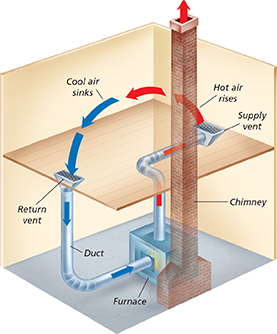Electric Baseboard Heating
An electric baseboard heater uses electrical energy to heat a room. A conductor similar to the heating element in an electric stove is used to convert electrical energy to thermal energy. The hot coil heats the air near it by conduction and radiation. Then convection circulates the warm air to heat the room.
Radiant heaters are similar to electric baseboard heating. They are often sold as small portable units, and are used to supplement a central heating system. These “space heaters” are easy to turn on and off and to direct onto cold toes or other areas where heat is needed most. Sometimes these heaters have a fan that helps to circulate heat.
Forced-Air Heating
To maintain even room temperatures, forced-air heating systems use fans to circulate warm air through ducts to the rooms of a building. In a forced-air heating system, shown in Figure 15, convection circulates air in each room. Because the warm air entering the room rises toward the ceiling, the warm-air vents are located near the floor. Cool room air returns to the furnace through floor vents on the other side of the room. One advantage of forcedair heating is that the air is cleaned as it passes through filters located near the furnace.

Figure 14 In a forced-air central heating system, the hot air enters the room through a supply vent in the floor. The hot air rises as cooler, denser air in the room sinks. The cooler air returns to the furnace through the return vent. Inferring If the hot air supply vent were located near the ceiling, what would be the warmest part of the room?
dCooling Systems
Most cooling systems, such as refrigerators and air conditioners, are heat pumps. A heat pump is a device that reverses the normal flow of thermal energy. Heat pumps do this by circulating a refrigerant through tubing. A refrigerant is a fluid that vaporizes and condenses inside the tubing of a heat pump. When the refrigerant absorbs heat, it vaporizes, or turns into a gas. When the refrigerant gives off heat, it condenses, or turns back into a liquid.
Recall that thermal energy flows spontaneously from hot objects to cold objects.  Heat pumps must do work on a refrigerant in order to reverse the normal flow of thermal energy. In this process, a cold area, such as the inside of a refrigerator, becomes even colder.
Heat pumps must do work on a refrigerant in order to reverse the normal flow of thermal energy. In this process, a cold area, such as the inside of a refrigerator, becomes even colder.





